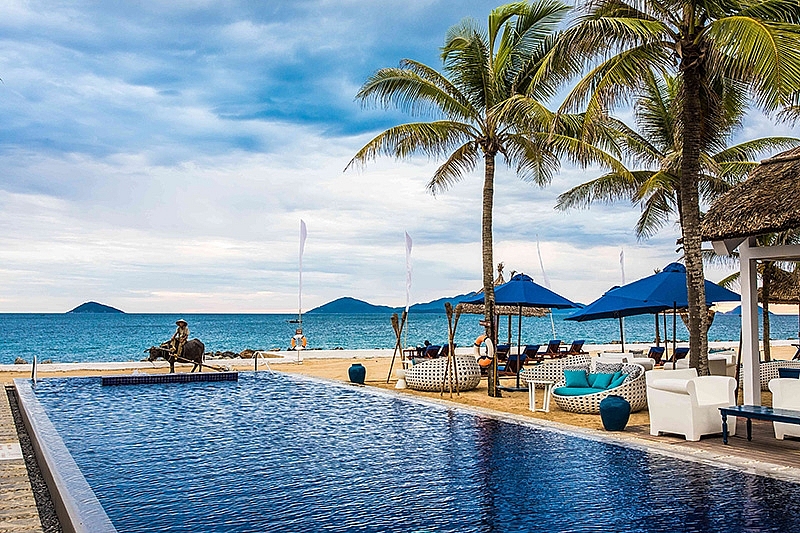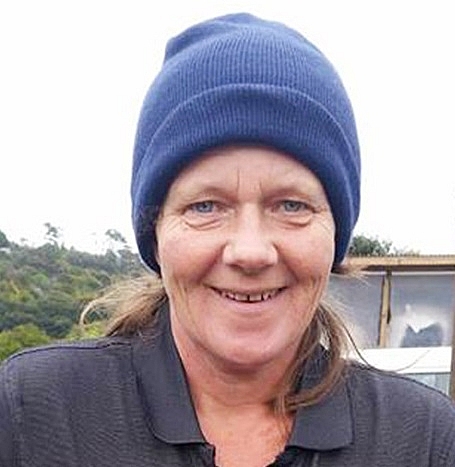Central coast in long-term erosion battle
 |
| Local authorities and hoteliers along the beach have been spending too much money on erosion prevention, trying to take action before it is too late, Source: Sunrise Premium Resort |
A REGION BLESSED BY NATURE, ATTACKED BY NATURE
Stretching 1,765 kilometres from Thanh Hoa to Binh Thuan provinces, the central region of Vietnam is blessed with a long coastal line of various beautiful beaches that are high on any traveller’s destination list and boasts huge possibilities for economic development.
Over the years, the infrastructure system along this coastline has been upgraded and rapidly modernised in order to attract a vast number of domestic and international investors, as well as tourists.
This is especially true of central coast cities such as Danang. The city is backed by a clear and efficient master plan to help attract local and international investors in building modern and luxury properties. As a result business is booming along its coastal lines, which has led to a renewal of the image and reputation of the whole city.
Despite this rich nature and the luxurious facilities, many property and hospitality projects along Danang’s beaches continue to face various risks from natural disasters. Climate change, along with rising sea levels, is slowly altering the cycle of rainy and stormy seasons causing significant damage to businesses. At My Khe Beach in Ngu Hanh Son district, and Son Tra district’s Mau Thai Beach, sea erosion has destroyed long dykes, staircases, pavements, walking paths along the beaches.
In Quang Ngai province, there are 21 listed erosion sites, including five suffering from serious erosion. At its My Khe and Sa Huynh beaches, some hotels and households have been affected by rising sea levels despite the creation of stone embankments. The 134km-long coastline along Quy Nhon city and Nhon Ly in Binh Dinh province, where the FLC resort complex is located, also suffers from land erosion.
The emerging province of Phu Yen, where a vast number of leisure and luxury property and hospitality projects are under construction, is looking to combat the phenomenon of rising sea levels and tides even though the area is less at risk to heavy storms. “We have to increase our capital in order to upgrade and consolidate the foundation of our project, and to prevent tide phenomenon and sea erosion,” said Van Tat Thang, investor of the Rosa Alba Resort project in Phu Yen.
Further north, Thua Thien - Hue province has focused on promoting its Lang Co and Thuan An beaches to attract investors. Though the region is blessed with white sand, clear blue sea and gentle waves, the emergence of climate change is causing severe weather conditions with unforeseeable circumstances. “Sometimes the weather is very beautiful with brilliant sunshine in the morning, but after just a few minutes we can see heavy rain for the rest of the day. Our guests are then often forced to remain inside the resort,” said Tran Van Hong, representative of Lang Co Beach Resort.
Nhat Le Beach in Quang Binh province, one of the top 10 most beautiful beaches in Vietnam, is also suffering seriously from sea erosion. The province’s Ly Hoa Dyke in Hai Trach commune has collapsed due to a landslide underneath its base.
Unfortunately extreme weather conditions resulting in complex tides, landslides and sea erosion are threatening every coastal province within the central region. Here 268 erosion sites have been recorded, of which the smallest site covers 1.4 hectares, with the largest covering 262.8ha.
LOCAL AUTHORITIES’ ACTIONS
“In recent years, heavy rain, storms, tide phenomenon and rising sea levels have occurred more densely. At the same time the average temperature increases, rainy season lasts longer, and storms are stronger. In all the central coastal provinces, natural disasters are becoming more severe and damage increases but we always lack the financial means to repair the damage,” said Van Phu Chinh, director of the Flood and Storm Control Center in Central and Central Highlands Vietnam.
Facing serious erosion issues Huynh Duc Tho, Chairman of the Danang People’s Committee, has directed local authorities to research and submit urgent solutions to help control the situation.
In Binh Dinh, local authorities submitted a petition to the government and related ministries to finance nearly VND5 trillion ($221.2 million) to solve sea erosion and river mouth refill situations which is causing deterioration of local living and working conditions.
To protect beaches, projects and investors, Thua Thien - Hue has invested over VND300 billion ($13.2 million) for building an embankment system along Thuan An – Tu Hien Beach.
The less well-off province of Quang Binh has been totally dependent on support from the government. After a heavy storm in 2017, the province suffered significant damage to its sea dyke system and is still awaiting central government financial support.
The support shortage for dyke construction and large-scale repairs is also causing headaches in Quang Tri province. Its long system of sea dykes now suffers from several broken sections that affect thousands of families living along the coast.
“We have mobilised local residents to plant tree corridors along the coast to combat erosion at broken sections, while waiting for capital support from the government,” said Le Da Son, director of the Quang Tri Department of Irrigation, Flood and Storm Prevention.
TOURISM ENTREPRENEURS REACT
While local authorities try to deal with continuing damage, severe weather, and shrunken beaches, tourist businesses along the coast have felt the pinch. To help protect from losses across the board, many property and hospitality groups share their budget in order to repair damages as well as to protect themselves out of any negative impacts.
“Tourism industry is directly affected by rising sea levels, especially the hoteliers along the central coastal region. Their properties are in danger every day so they are aware of the impact of climate change, and consider natural friendliness to be a factor connected closely to their business growth,” said Pham Ha, CEO of Luxury Travel.
The central coastline of Hoi An is an example of a location suffering heavily from land erosion since 2004. Dozens of resorts along the coast have been in danger of losing their beach properties and tourism has been adversely affected. They have been spending too much money on erosion prevention, in an attempt to take action before it was too late.
The Victoria resort in Cua Dai beach has had to spend billions of VND annually to upgrade a sea dyke to cope with the problem, but the outcome has not been satisfactory. At Golden Sand resort, beach erosion had even crept up as far as the edge of the swimming pool.
Sunrise Premium Resort, which is also located along Cua Dai Beach, experienced its biggest loss between 2009 and 2014, a period in which it spent close to $3 million just to protect the property.
“Customers choose the central coast usually for its pristine beaches. We have a large customer base from Europe and Australia – people who very much would like to enjoy swimming in the ocean and a typical beach holiday. Our rates took a direct impact from these natural disasters, at least 50 per cent lower,” said Sven A.Saebel, general manager at Sunrise Premium Resort.
The annual storm season is a constant challenge for the local staff and properties, as the coastal hospitality sector expects damages which can range from minor to heavy rebuilding. At Sunrise Premium Resort, a recent seawall breach forced it to stabilise the grounds with hundreds of thousands of cubic meter rock.
| Sven A. Saebel - General manager Sunrise Premium Resort
We have found solutions working with specialists to protect our shoreline by deep drilling a solid concrete seawall, and building a natural wave breaker of 20,000 cubic meter rocks. This certainly protects the resort in the short-term; a long-term solution would be to build a marina. However this requires an overall solution to our erosion problem, and every resort has to follow the same structure as a combined team effort. Environmental protection along the Central Coast is quite active, from quarterly deep cleaning roads and beaches, reducing waste, and removing plastic as much as possible. We are also looking for next year into solar systems to support hot water and electricity supports. Claire Mummery - Australian tourist
Australia has replenished eroded beaches by pumping sand from areas where it had been built up, such as river mouths. One thing we notice about Vietnam in general that detracts from the beauty is the amount of litter. This, at least, is something that can be remedied at a local level. But we would come back to your country again. Beaches are not the only reason for me to visit Vietnam though I love tanning on the sunny white sandy beaches very much. So besides pretty beaches, your country should maintain a traditional style of living and wild natural beauties. It’s not easy to find places that are not dependent on technology and commercialisation. Modernism is essential to improve places, but it can sometimes kill valuable traditional aspects. I can experience the lifestyle of the people even though I stayed in one of the beach resorts, because it was located near real residential homes. |
What the stars mean:
★ Poor ★ ★ Promising ★★★ Good ★★★★ Very good ★★★★★ Exceptional
 Tag:
Tag:
Related Contents
Latest News
More News
- The destinations powering Vietnam’s festive season travel demand (December 04, 2025 | 18:33)
- Vietnam named among the world’s most exciting winter destinations (December 04, 2025 | 15:10)
- Phu Tho emerges as northern Vietnam’s new tourism hub (December 01, 2025 | 17:00)
- Vietjet completes Airbus A320/A321 updates ahead of deadline (December 01, 2025 | 09:49)
- Vietjet resumes Con Dao flights from early December (November 28, 2025 | 15:24)
- Free tickets, Lunar New Year promotions on offer at Vietjet Mega Livestream (November 26, 2025 | 15:32)
- Scandinavian Airlines and Vietnam Airlines broaden agreement with new routes (November 25, 2025 | 17:04)
- Halong Cruise Port welcomes over 3,100 international visitors (November 12, 2025 | 18:06)
- Vietnam.travel climbs to second place in Southeast Asia website rankings (November 12, 2025 | 18:01)
- Cat Ba named among Southeast Asia’s top island adventures (November 11, 2025 | 18:09)


























 Mobile Version
Mobile Version